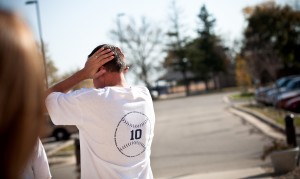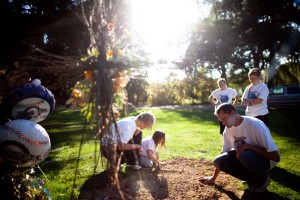One is too many
Featured, Features — By Sammy Ganz“The whole car just exploded from the inside. My first sense of smell was that the car was on fire. I was talking to Rosie saying ‘we gotta get the kids out of the car,’” Mike recalls. They desperately tried to free Treyton and Kindyl but could not open the back doors. Rosie found a way to get Kindyl out of her seat, but they could not reach Treyton, who sat slumped over, as if he were sleeping.

Mike Kilar places his hands over his ears as he walks out of the Walworth County Judicial Center, where he saw Dragotta for the first time since the crash. Photo by Lukas Keapproth
“Kindyl was screaming, and Rosie was screaming, her leg hurt. I was trying to comfort them, trying to talk to Trey. I was overcome from what I had been hit with and started to pass out.” Mike signaled to Brian Bilitz, the man whose property they landed on, for help. Brian led Mike to a clear place on the ground to lie down. As soon as a police officer arrived, Mike called out to him, “You need to get to my son, he needs help.”
—
Ten minutes after her family left the volleyball game, Mary headed to her car and started driving home. Noticing an accident on the road ahead, she pulled over on Highway 20 to contact her family. After several calls and texts went unanswered, she parked to walk over to the scene. As she closed the car door, her phone rang to confirm what she already suspected, “Your family has been in a terrible accident.”
“I walked across the street to find Mike lying on the ground with Kindyl. He said, ‘Go to Trey, he needs you.’” Mary jumped through the car window to reach Trey, his door still too damaged to open. A police officer had Trey’s blonde-haired head stabilized in his hands. She talked to Treyton, assuring him that Mom is here and loves him. Finally, the officers and paramedics took Treyton out of the vehicle through the back hatch, the rest of it too crushed in to find a clear opening.

Mike Kilar touches his son's recently-dug grave. In the background, his wife and youngest daughter draw a smiley face in the dirt for Trey. Photo by Lukas Keapproth
Four ambulances waited at the scene, ready to transport the Kilars 17.7 miles to the nearest hospital. Still not knowing the extent of the injuries her family members endured, Mary had to choose which to go in. One ambulance held her terrified, but fully conscious, 5-year-old. Another held her 6-year-old, who had not responded since the crash. Luckily, friends driving back from the game stopped to offer help. “I went into director mode. I asked that one go in an ambulance with Kindyl, that the paramedics keep Mike and Rosie together and then I rode with Treyton because he was most serious.”
Treyton never responded — at 9:42 p.m., the hospital pronounced him dead. Mike — immobilized from the accident with broken neck bones in vertebrae C6 and C7, a broken collarbone, and a fractured sternum — had to say goodbye to his only son through a mirror held up by his friends. Grandma J held a phone to Treyton’s ear so Mike’s parents in Illinois could tell him they loved him. She remembers saying her own goodbyes to Treyton. “He had no visible marks on his face. He did have a tube in, but no bruises on his face. It was like we could just pick him up and take him home.”
The hospital generously let the Kilars spend as much time as they wanted with Treyton before taking him to the coroner. “Finally at about 5 in the morning, I went to [the hospital staff] and said it will never be enough for [Mary], she’ll never want to leave him, so I think you’re going to have to tell her it’s time,” says Grandma J. “He was starting to be so cold … She had crawled into the bed with him and held him.”
When she left that bed, Mary’s numbers changed forever. She lives each day focusing on her three living children and preserving Treyton’s memory. Her 5-year-old daughter asks questions of a teenager, “Is your car safe? Does it have airbags?” and sometimes isn’t accepting of the answers. “Well, the airbags didn’t keep my brother safe.”
“That’s hard as a mom, trying to put that safety net back on your children and make them feel safe when something out of my control happened to them,” Mary says. “Our children who are living need us right now. What we are doing right now is going to affect them for the rest of their lives and to be frank, we could really mess that up.”

The Kilar family sits on their front porch, holding two pumpkins from Treyton's beloved garden. Pictured from left to right: Rosie, Brittany, Kindyl, Mary and Mike. Photo by Lukas Keapproth
Mary’s three daughters are not her only kids — she has a whole school of them. As the principal of St. John the Baptist School in Jefferson, Wis., Mary is a role model to children in preschool through eighth grade. In the aftermath of this tragedy, she says the students have helped her heal. “They know what they can do right now is to show each other kindness and caring and love.” They have gone far beyond that to honor Trey. The school council came together, inspired by how Treyton taught them to treat one another, and had each student write a “caring card” with something Trey would have done. One card is read over the announcements each morning.
These anecdotes, and the hundreds of notes they’ve received about Trey, empower the Kilars to stay strong. “We aren’t going to disappoint him. We want to stay true to him. We want to stay true to our other kids and protect them for what their future holds.”
Part of this involves staying true to the cause of Treyton’s death. Mary struggles with how people characterize what happened to Trey. To her it was not an “accident” but a decision that could have been avoided.
Rosie felt at fault for Treyton’s death because they would not have been at that spot in the road if they hadn’t gone back for something she left behind.
“We have so many ‘what ifs’ in this,” Mary said in response. “What if we had left early? What if we had left later? What if we hadn’t come tonight? Who is at fault?”
“That man,” Rosie said.
“Yes,” Mary said, “for the choices he made.”
Tags: Ganz, Treyton Kilar




 Digg This
Digg This Bookmark
Bookmark Stumble
Stumble